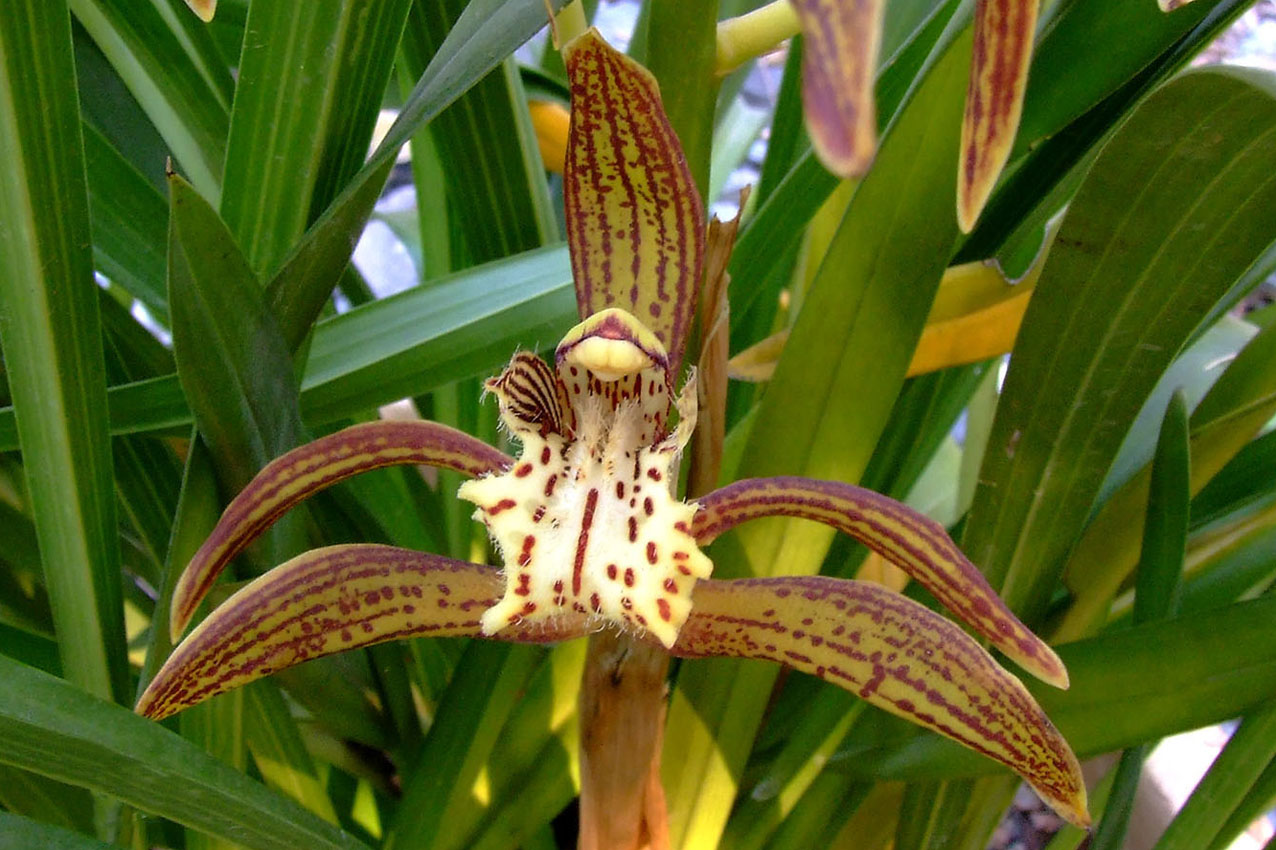Abstract
This study describes a new orchid species, Cymbidium motuoense, from Xizang, China based on morphological and molecular analyses. Several unique morphological features distinguish this new orchid from all other species of Cymbidium. Based on its morphology, this orchid is similar to C. tracyanum but differs in its yellow-green flower with dark purple-red spots on the veins, oblong-elliptic sepals, side lobes of the lip with reddish brown hairs along the veins and disc with three purple-red lamellae. Phylogenetic analyses based on plastid DNA (matK and rbcL) supported C. motuoense as a new species. However, the low support in nuclear ribosomal ITS tree provide the possibility that the new orchid may be a natural hybrid of C. tracyanum and C. iridioides or another closely related species.
References
<p>Chen, G.Z., Huang, J., Zhang, G.Q., Ma, L. & Chen, S.P. (2017) New subtribe Pachitinae (Orchideae) of Orchidaceae: evidence from morphological and molecular analyses. <em>Phytotaxa</em> 329: 114–126. https://doi.org/10.11646/phytotaxa.329.2.2</p>
<p>Chen, S.C., Liu, Z.J., Zhu, G.H., Lang, K.Y., Ji, Z.H., Luo, Y.B., Jin, X.H., Cribb, P.J., Wood, J.J., Gale, S.W., Ormerod, P., Vermeulen, J.J., Wood, H.P., Clayton, D. & Bell, A. (2009) <em>Orchidaceae. In:</em> Wu, Z.Y., Raven, P.H. & Hong, D. (Eds.), <em>Flora of China</em>, vol. 25. Science Press, Beijing & Missouri Botanical Garden Press, St. Louis, pp. 211–235.</p>
<p>Du Puy, D.J. & Cribb, P.J. (2007) <em>The genus</em> <em>Cymbidium</em>. Royal Botanic Gardens, Kew, Richmond, 359 pp.</p>
<p>Don, D. (1824) <em>Prodromus Florae Nepalensis</em>. Gale, London, 36 pp.</p>
<p>Hunt, P.F. (1970) Notes on Asiatic orchids 5. <em>Kew Bulletin</em> 24: 93–94. https://doi.org/10.2307/4103252</p>
<p>Jiang, Y.T., Ma, L., Lin, R.Q., Xiong, Y.F., Jiang, S.Z., Liu, B., Liu, Z.J. & Chen, S.P. (2020) <em>Cymbidium codonanthum</em> (Orchidaceae; Epidendroideae; Cymbidiinae), a new species from China: evidence from morphological and molecular analyses. <em>Phytotaxa</em> 453: 275–283. https://doi.org/10.11646/phytotaxa.453.3.9</p>
<p>Feng, G.M. & Li, H. (1980) A new species of Orchidaceae from <em>Cymbidium. Acta Botanica Yunnanica</em> 2: 334–336.</p>
<p>Huang, M., Liu, Z., Yang, G. & Yin, J. (2017) An unusual new epiphytic species of <em>Cymbidium</em> (Orchidaceae: Epidedroideae) from Hainan, China. <em>Phytotaxa</em> 314: 289–293. https://doi.org/10.2307/4103252</p>
<p>Liao, X.Y., Liu, X.D., Jiang, Y.T., Zhang, D.Y., Lan, S.R. & Liu, Z.J. (2019a) <em>Cymbidium atrolabium</em> (Orchidaceae; Epidendroideae), a new species from China: evidence from morphological and molecular data. <em>Phytotaxa</em> 423: 87–92. https://doi.org/10.11646/phytotaxa.423.3.4</p>
<p>Liao, X.Y., Zhang, D.Y., Lan, S.R. & Liu, Z.J. (2019b) <em>Paphiopedilum erythroanthum</em>, a new species of slipper orchid (Cypripedioideae, Orchidaceae) from China based on morphological and molecular data. <em>Phytotaxa</em> 406: 271–278. https://doi.org/10.11646/phytotaxa.406.5.2</p>
<p>Liu, Z.J., Chen, S.C. & Ru, Z.Z. (2006) <em>The genus </em>Cymbidium<em> in China</em>. Science Press, Beijing, 237 pp.</p>
<p>Miller, M.A., Pfeiffer, W. & Schwartz, T. (2010) Creating the CIPRES Science Gateway for inference of large phylogenetic trees. <em>In: Proceedings of the Gateway Computing Environments Workshop (GCE), 14 Nov. 2010.</em> New Orleans, pp. 1–8. https://doi.org/10.1109/GCE.2010.5676129</p>
<p>Peng, Y.L., Zhou, Z., Lan, S.R. & Liu, Z.J. (2019) <em>Cymbidium jiangchengense</em> (Orchidaceae; Epidendroideae; Cymbidiinae), a new species from China: evidence from morphology and DNA sequences. <em>Phytotaxa</em> 408: 77–84. https://doi.org/10.11646/phytotaxa.408.1.6</p>
<p>Ronquist, F. & Huelsenbeck, J.P. (2003) MrBayes 3: Bayesian phylogenetic inference under mixed models. <em>Bioinformatics</em> 19: 1572–1574. https://doi.org/10.1093/bioinformatics/btg180</p>
<p>Schlechter, R. (1924) Die Gattungen <em>Cymbidium</em> Sw. und <em>Cyperochis</em> Bl. <em>Repertorium Novarum Specierum Regni Vegetabilis</em> 20: 96–110. https://doi.org/10.1002/fedr.19240200605</p>
<p>Seth, C.J. & Cribb, P.J. (1984) A reassessment of the sectional limits in the genus <em>Cymbidium </em>Swartz. <em>In:</em> Arditti, J. (Ed.) <em>Orchid Biology: Reviews and Perspectives III.</em> Comstock, Ithaca, pp. 283–332.</p>
<p>Sharma, S.K., Suman, K., Pramod, T. & Rama, S.R. (2012) Comparative karyomorphological study of some Indian <em>Cymbidium </em>Swartz, 1799 (Cymbidieae, Orchidaceae). <em>Comparative Cytogenetics</em> 6: 453–465. https://doi.org/10.3897/compcytogen.v6i4.3461</p>
<p>Swartz, O. (1799) Dionome Epidendri generis Linn. <em>Nova Acta Regiae Societatis Scientiarum Upsaliensis</em> 6: 61–88. [https://www.biodiversitylibrary.org/item/261100#page/86/mode/1up]</p>
<p>Swofford, D.L. (2002) PAUP*. <em>Phylogenetic analysis using parsimony (*and other methods), v. 4.0 beta 10.</em> Sinauer, Sunderland.</p>
<p>Xu, X., Ding, C.C., Hu, W., Yu, X., Zheng, Y, Liao, X., Liu, X., Liu, Z.J & Lan, S. (2021). <em>Cymbidium xichouense</em> (Orchidaceae; Epidendroideae), a new species from China: evidence from morphological and molecular data. <em>Phytotaxa</em>, 484: 291–297. https://doi.org/10.11646/phytotaxa.484.3.4</p>
<p>Yu, X., Zeng, M.Y., Chen, G.Z., Xu, X.Y., Bi, Y.Y., Chen, J.T., Wang, Q.Q., Hu, W.Q., Zhang, D.Y. & Liu, Z.J. (2021) <em>Cymbidium weishanense</em> (Orchidaceae; Epidendroideae), a new species from China: evidence from morphological and molecular data. <em>Phytotaxa </em>500: 45–50. https://doi.org/10.11646/phytotaxa.500.1.6</p>
<p>Zhang, D.Y., Tu, X.D., Liu, B., Liao, X.Y., Lan, S.R. & Liu, Z.J. (2020) <em>Cymbidium biflorens</em> (Orchidaceae; Epidendroideae), a new species from China: evidence from morphological and molecular data. <em>Phytotaxa</em> 428: 271–278. https://doi.org/10.11646/phytotaxa.428.3</p>
<p>Zhou, Z., Zhang, D., Chen, G.Z., Yu, X., Li, C.R., Lan, S.R. & Liu, Z.J. (2020) <em>Cymbidium brevifolium</em> (Orchidaceae; Epidendroideae), a new species from China: evidence from morphological and molecular data. <em>Phytotaxa</em> 464: 236–242. https://doi.org/10.11646/phytotaxa.464.3.5</p>


